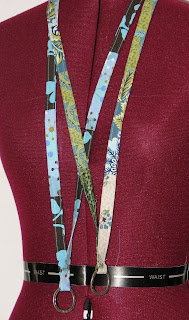
Thank you so much to Mamafitz, Sarah, Debbie, Carla, Katherine, Summerset and Mary for talking back to my confession last week! I asked how much attention people pay to the grain line in their fabrics and got an interesting collection of responses – some areas of strong agreement and others not so much…
There are basically 2 issues:
First, are the horizontal threads and the vertical threads in the fabric actually perpendicular to one another? This tells you if your fabric is on-grain or not.
Second, do you take care to align the arrows printed on the pattern pieces with the grain (or the bias) of the fabric, as directed?
Most people (5 out of 7) reported that they do pay attention to the grain line of their fabric. In fact, every single person indicated that she aligns the pattern pieces along the fabric grain line as directed.
(I wish I could get my friend Ana to do this – she is so driven to use every single scrap of fabric, that she completely disregards the grainlines marked on the pattern pieces.)
Finally, when the fabric is not well squared up, no one puts much effort into trying to fix it – most people just move on to a different piece of fabric. Mamafitz, for example, explained that even if you can “fix” the fabric, it goes back to its original shape after it is washed.
The differences came up when people started talking about how they attend to the grain line. For example, 3 out of 6 will rip the edge of a piece of fabric (like a cotton print) to make sure that they are folding it along the grain. But, 3 out of 6 won’t. (And Debbie noted that this can distort the edges…)
Similarly, half the commenters will pull a single thread out of the fabric (near the edge) – again, to make sure that they have identified the grain line – and the other half won’t.
Those are the 2 most common (as far as I know) methods of finding the grainline of your fabric. Mamafitz uses a gridded cutting mat to make sure that everything is nice and square and lined up. Katherine will sometimes just eyeball the weave carefully and/or drape the fabric over her hand to see how well it hangs. She also tugs on her fabric at various angles to try to find the best bias line. And Debbie will mark a single rib in a knit fabric.
Those are the 2 most common (as far as I know) methods of finding the grainline of your fabric. Mamafitz uses a gridded cutting mat to make sure that everything is nice and square and lined up. Katherine will sometimes just eyeball the weave carefully and/or drape the fabric over her hand to see how well it hangs. She also tugs on her fabric at various angles to try to find the best bias line. And Debbie will mark a single rib in a knit fabric.
As for the “why?” of grainlines, several people mentioned that your clothes simply won’t look their best if you don’t pay attention to the fabric grain. But not everyone agreed that this will make a big difference.
In my sewing experience, the impact of paying attention to fabric grain is more likely to show up when I’m either (a) lining something or (b) making something reversible. I’ve found that, if I don’t make sure that each piece is on grain, those 2 fabrics fight each other and the garment really doesn’t hang well at all. For me, it’s much less obvious in single-layer garments.
See links embedded in the photo for reversible patterns & tutorials.
Thanks again to everyone who took the time to comment! You guys rock! :)
Photo credit: Patterns Only





















































